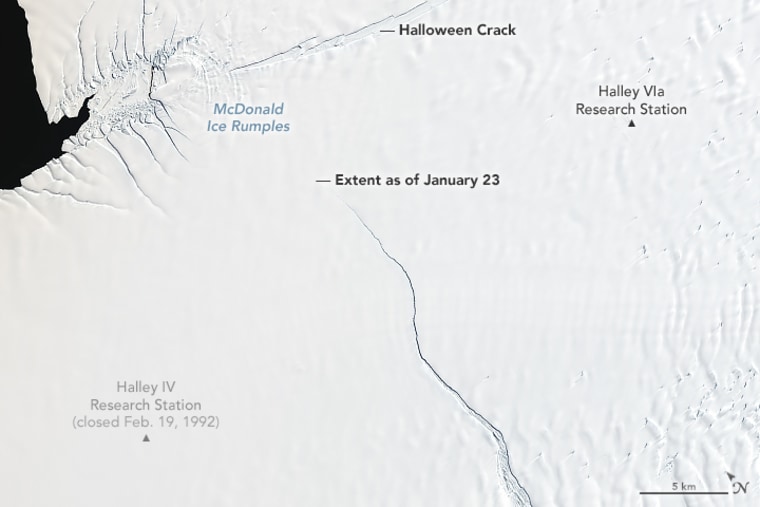An iceberg roughly twice the size of New York City could soon break off an ice shelf in Antarctica, according to NASA scientists who are monitoring an enormous crack that is spreading across the sprawling slab of ice.
The space agency recently released satellite photos of Antarctica’s Brunt Ice Shelf, where a rift can be seen cutting across the shelf. NASA scientists said the crack had been stable for about 35 years, but has since been creeping north at a pace of about 2.5 miles per year.
This rift is accelerating toward another fissure — known as the Halloween crack — that is located less than 3 miles away. The Halloween crack, which was first observed in October 2016, continues to spread east, and when the two rifts intersect in the coming days or weeks, an iceberg measuring at least 660 square miles will likely break off the ice shelf.
Scientists are unsure what this process, known as calving, could mean for the future health and stability of the Brunt Ice Shelf.
“At worst, this calving could destabilize the remainder of the Brunt Ice Shelf leading to its complete collapse,” Dominic Hodgson, a senior scientist at the British Antarctic Survey, told NBC News MACH Tuesday in an email. “This would then likely be followed by an acceleration of ice in the upstream glaciers, increasing their contribution to sea level.”
The newborn iceberg would be the largest to break off the Brunt Ice Shelf in more than 100 years, but as far as Antarctic bergs go, it would be a relative pipsqueak. NASA estimated that an iceberg of that size would not even make the list of the 20 biggest Antarctic icebergs.
One of the largest icebergs in recorded history, measuring 2,200 square miles or nearly the size of Delaware, spawned from Antarctica’s Larsen C ice shelf in 2017.
Iceberg calving is a natural phenomenon that occurs during the life cycle of an ice shelf, but scientists say climate change is causing Antarctica’s ice shelves to thin.
“In recent decades the rate of ice loss has accelerated in many areas, and in some cases complete ice shelves have broken up,” Hodgson said in the email. “This has in most cases been linked to a combination of measured atmospheric and ocean warming in the region; melting the ice shelves from above and below.”
This could have serious consequences for scientists who work in Antarctica, including researchers with the British Antarctic Survey, which maintains the Halley VI Research Station on the Brunt Ice Shelf.
The Halley facility, where scientists conduct crucial Earth, atmospheric and space science, is typically open year-round but has been closed twice in recent years due to worrisome ice conditions.
